Table of Contents
- Introduction
- The Myth of the Plug?
- Return to Ripple Town
- Sounds from Earth
- HTML Hyper Tensions Mindful Liberation
- Notes After A ChattyLARP
- Pi-Rats LARP
- Draw-it-with-others
- Self-Organized [re]work session {(1)}: Breaking the Organigram
- Self-Organized [re]work session {(2)}: Infrastructural Explorations
- Self-Organized [re]work session {(3)}: Alternative Economies
- Boiler room Inspections
- Colophon
- Bibliography
Introduction
The H&D Bulletin is an occasional publication that brings together practical and reflective articles, conversations and manuals, experimental, poetic, visual, or otherwise speculative contributions from the H&D cosmos.
The bulletins are published and distributed via the H&D website and the H&D mailing list. Printed copies are distributed through independent book stores, publishing fairs and the H&D network whenever there is an opportunity.
This edition of the H&D bulletin reflects on the rework sessions we hosted surrounding the topic of self-organization, and the past summer camp. To this end, we invited a variety of participants to share about their workshop. This bulletin was assembled, edited and designed using Octomode, an experimental publishing tool developed by Varia members. Octomode is a collective editing space for making PDFs, using Etherpad, Paged.js, and Flask. Varia is a Rotterdam-based collective and space for developing collective approaches to everyday technology (https://varia.zone/en/).
“Inspired by the non-centralized, tentacular cognitive capabilities of the octopus, we imagined a space in which the artificial boundaries of writing and designing can be crossed; where writing, editing, and designing can be done in one environment simultaneously, allowing the format to influence the matter and vice-versa.”
The myth of the plug ?
・゚゚・。 Adèle & Leo *・。・゚゚

Electricity is often taken to be an infinite, given resource in the western context we live in. Even if we feel sensitive to our energy consumption in our everyday lives, the infrastructures that produce and move electrical energy stay too complex, mystical, if not completely invisible. When we turn on a kettle, we do not imagine the resources and infrastructures needed to generate the electricity needed to heat the water so quickly. This ignorance is a privilege and lies at the heart of an economy based on the extraction and increasing consumption of earth’s resources. This economy itself is part of a (neo-)colonial, exploitative and capitalist system that should be abolished. We think it is important to understand electrical energy, to make visible its amount in our daily lives, and to become aware of its limits as an inseparable parameter of our actions. We believe that before thinking about “green” electricity or renewable energy, we must first question our electricity consumption and think about our energy needs and the limits of the resources available to us.
At the Hackers & Designers summer camp, we gathered in a circle in the barn to talk about the functionalities and principles of electricity. We reminded ourselves of our physics classes, formulas, and the relation between ampere, watt and volt. We then distributed watt meters and dissolved into small groups to measure the electricity consumption of all the appliances we could find, writing it all down into a table of consumption.
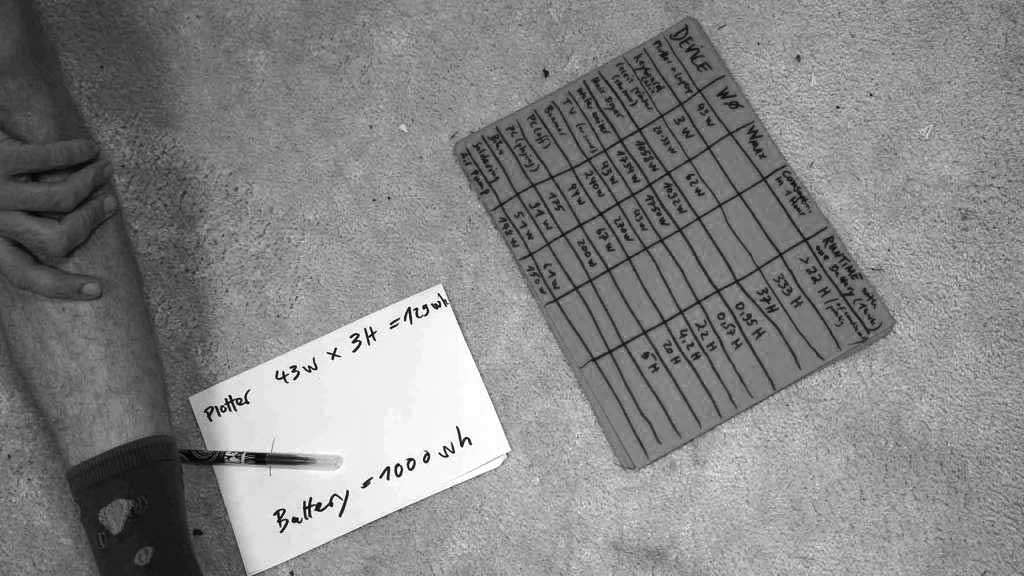
With this exercise, it becomes a bit more conceivable to change our relationship with electricity, as it shows a glimpse of the one we have. Envisioning a clearer limit on the amount of energy we can consume radically changes the way we carry out our projects and our daily lives. In the context of the Hackers & Designers summer camp, we realized the crazy amount of energy we spent on making coffee making or blow-drying our hair for example. This understanding leads us to choose our appliances wisely and organize moments and times for an activity on a more community-based level.
Another main subject of this summer workshop was electricity storage and batteries. How are big batteries built? What kind of materials are used in their battery cells? How do charging and discharging work?? Where are they used? Where can we find them? What kind of autonomy can it offer in relation to the electricity grid system? And what they allow us to do? With batteries, the limit of power becomes really clear. They give us restricted amounts of energy for a precise amount of time, depending on our activities, and power consumption of devices used in these activities. Taking on board this limitation, how do we organize? Do we want to power a sound system with intense bass for one hour, a video projector and small speakers for nine hours, or three lights for several days? These seemingly technical questions actually raise issues of personal habits and collective organization. Energy therefore appears to be a parameter that structures the way we live together.
Another example of the use of a battery is to build portable USB battery kits to share. A friend of mine told me about a 5 volt USB battery kit that was placed in a common space in a squat. The main use for this kit was to charge the telephones of the people living there. When people would come out of their room and enter into this common space to plug their phone and benefit from some watts, the battery would also power a garland to light up the place nicely. In this space, people meet and spend time together. In the future, this USB kit will be used somewhere else by different people. This is an example of how the collective use of energy demands and produces collective organization.
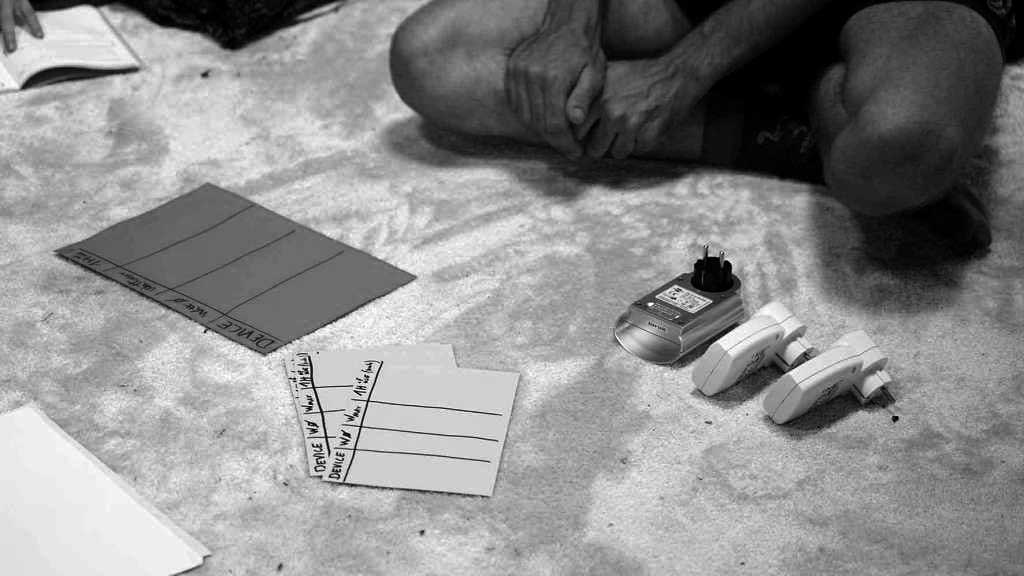
With batteries, we can quickly fantasize about autonomous systems. It’s important to emphasize that this is only a relative form of autonomy. A battery system makes it possible to work without the electricity grid for a given time and space, but it depends on it for recharging in the absence of any other means of generating energy (solar panels and wind turbines, water turbines, magic, a plug in a bank or in a capitalist café, etc.). Again, the resources required to manufacture equipment for electrical energy production and storage systems are exhaustible and their extraction is ethically and ecologically problematic. Nevertheless, trying to adapt our practices to low-tech and DIY/DIT (do-it-together) energy infrastructure, is a precious step in collective learning and a tool to create alternative imaginaries and approaches of dealing with electricity.
To wrap up the workshop, we powered a plotter printer to a home-made mobile energy system to print a secret. To be continued… We hope you feel empowered <3.
Return to Ripple Town
・゚゚・。 Daniel Murray *・。・゚゚
Molly Moose spotted a conch that was suspiciously hopping along the dusty road. “Hoy… Are you a conch? So far from the sea?” The conch nodded and replied, “Hoy moose. Tell me, is this the road to Ripple Town?” Molly looked around, “Why, yes it is. Ripple Town is where I am headed, would you like to join me on my walk?” The conch swooshed about, saying, “I only hop, but I would be happy to hop while you walk.” This seemed like a fair compromise, so they set off down the road together.
Looking around, the conch said, “It’s awfully funny to be on a road. What are those sea weeds that grow on either side?” “Oh, those are land weeds, we call them lemon trees, and they grow for miles around Ripple Town. Sometimes the lemons run free and we have to take shelter.” Molly tried shaking a lemon tree and the lemons wobbled precariously, as the conch looked worried.
A little way ahead they could see a lion sitting on the road. “I would like an umbrella to spin and spin, on the rooftops in the rain,” said Lorm the Lion to a large rock, but the rock did not respond. As Molly and the conch approached, he offered them some toast. They thanked him, “Why thank you lion, everyone loves toast! Perhaps you would like to join us on our way to Rippl…” Molly started, before noticing Lorm had fallen asleep; so they left him be.
“As a conch I am known to hop,” explained the conch after a long silence. “I hop to many places. Sometimes to lunch, and sometimes to trains, and sometimes to museum exhibits, and sometimes to the dentist. All these reasons to come and go; they bob past like days and dreams.” “That’s true,” Molly nodded in agreement as they stopped at an old stone crypt. The conch looked sad and said, “This is the end of my journey.”
Just then, the crypt opened and Melanie the Mummy stepped out grinning. “Hoy conch, thank you for coming to my birthday party, who is your friend?” “I’m Molly Moose, and I’m on my way to Ripple Town!” “Please come in for refreshments,” Melanie cackled as she ushered them towards a group of thirsty spiders talking about tax returns.
The crypt was full of crypt toys, each beautifully painted with eyes and parrots and swords. Melanie gestured at the labyrinth of glittering trinkets, brooding doors, and glowing crystals all around. “Would you like a tour? It goes on forever!” “Oh, that sounds wonderful, but I must be leaving soon,” nodded Molly. “You are a lot like this crypt, Molly Moose, full of wishes for your next life; don’t let them get dusty!” Melanie winked, before joining the other guests dancing to the Bangles. Everyone, including the conch, gathered outside and waved and cried when Molly left, and she felt herself mourning too, after the stone door clunked shut behind her.
It was dark now, the sky was a deep purple, and the street lamps were glowing orange as Molly walked on alone. A shadowy figure loomed out of the darkness singing, “Sitting in the garden by a maple door, I’ve gathered the apricots and put them in the store; and while a hungry harvest is sometimes not much fun, I’m glad to have my apricots when summertime is done.” Molly smiled, “Ah, Gatherer Grim, you are working late.” “I am always working,” nodded Gatherer Grim as he floated away into the eternal haze of the night.
Molly stood under the stars that danced around the moon, and said, “Hoy moon, how far is it to Ripple Town?” And the moon replied, “Towns don’t exist dear Molly, they are made from actions, and shapes, and trains that weave like worms to the future.” “But moon! I want to go home and play video games.” Molly waited, but the moon only smiled, as the lemon trees softly hummed a lemon tune in the cool wind.
It was a good tune, and Molly found herself vibing down the road, until she found a pomegranate tree that was vibing too. They talked about what it was like to be a tree, but Molly couldn’t shake the feeling that sometimes the tree looked an awful lot like a crocodile and asked, “Are you, in fact, a crocodile?” And the tree said, “I am a Pomegranate Crocodile Tree!” Molly said she had never heard of such a thing, and the tree laughed, “Well now you have, also your bus is here!”
The pomegranate crocodile tree was right; as they had been talking, the first bus to Ripple Town had stopped nearby, and they both waved, as Molly climbed on board. The sun was just glowing over the horizon when the bus stopped again, and standing in the market square, where the seagulls do their squats, Molly grinned and said, “I am in Ripple Town!”
Sounds from Earth
・゚゚・。 H&D, dianaband, Hee-Ju *・。・゚゚
Sounds from Earth is a series of intergenerational workshops about world-building, live action role-play, and working with simple electronics. Together with workshop participants in Seoul and Amsterdam we co-created a fictional narrative, built a network of small electronic objects that facilitate (re)connection to and communication with our surroundings. The sounding network aimed at facilitating communication beyond the use of words, allowing to approach “nature” not as something to dominate and extract from but as something we are part of and live with and we need to relearn to attune to. Inspired by natural networks of communication such as mycelium, we asked ourselves how we can enter into meaningful exchange with the world around us and achieve a deeper sense of interconnectedness.
What information do we collect around us, what is legible, and what do we understand, interpret, and project meaning onto? What is lost in translation? Can we get comfortable with the miscommunications and the unknown?
・゚゚・。 Lore *・。・゚゚
It doesn’t matter what shape we have in this forest or what sounds we make, we are all interconnected. We each have our own personality but make sense as a whole. Resonants, Echoes, Weavers, Synergists, all connected by the wind. The wind is a vital force in our ecosystem and accompanies us through our cycles. Its unpredictable nature maintains our community, it’s bringing us the energy we need in mysterious ways.
An echo in the wind brought us a rumor: the wind could become still, which would threaten our unique ecosystem’s equilibrium… and sooner than we can imagine! We know this, because we attune to the wind and to each other. Our companions are made of extracted minerals and oils processed into components that we found discarded in our ecosystem… some of us know how to transform them into companions.
When the wind blows with a certain strength and in a certain direction, we come together and – with the help and company of the Synergists – send our wishes to the wind. The wind doesn’t understand words, only intentions through sounds, vibrations, blows and movements.
・゚゚・。 Residents *・。・゚゚
Role in the forest: We help interpret the wind’s messages and guide others accordingly.
Spell: We echo the sounds of the wind to discover its messages in the distortion of our voices.
Role in the forest: We strive to preserve the forest’s tone by maintaining our archive and understand how to align with the wind’s rhythm.
Spell: Dissonant low chant to collect sounds, wishes and worries for archival.
Role in the forest: We help our realm adapt to the wind’s changes by ensuring a balanced exchange of energies. We act as intermediaries, spreading the wind’s messages to maintain our collective polyphony and channeling back the energy of the forest to the wind.
Spell: We channel the forest energy into a chant to the wind.
Role in the forest: We build large and small paths and holes for the wind to travel through. It’s a constant practice so that nothing gets lost in the shuffle.
Spell: When a message from the wind is deciphered, we dance: rocks, sand and soil turn into paths, holes and walls.
HTML Hyper Tensions Mindful Liberation
・゚゚・。 Clara Pasteau *・。・゚゚
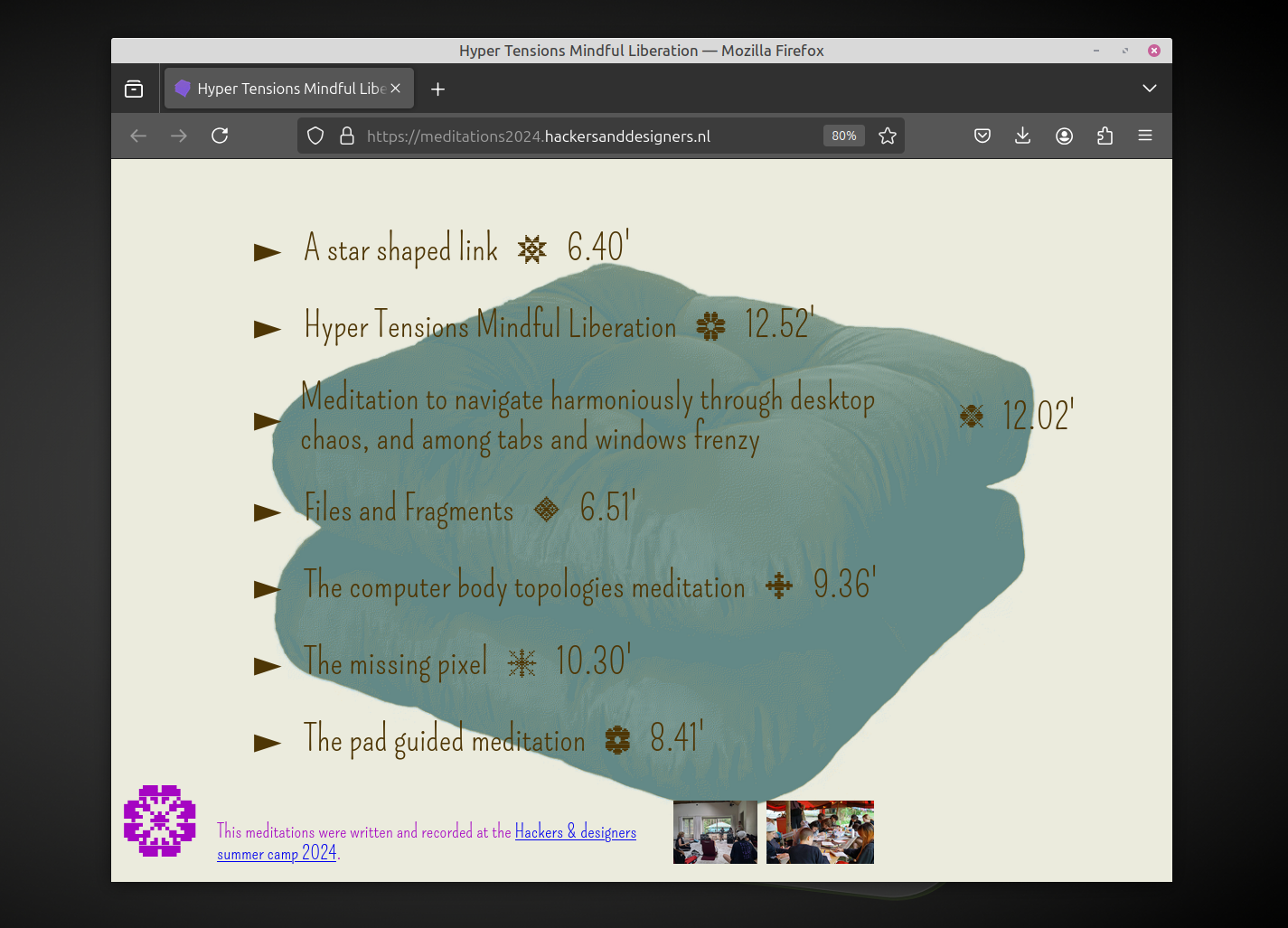
“Hyper Tensions Mindful Liberation” is a guided meditation workshop hosted by Clara Pasteau at the 2024 Hackers & Designers summer camp. The meditation experience uses HTML elements as metaphors for body parts to help participants explore their inner landscape. As part of the workshop, participants also wrote and recorded meditations. These meditations can be found on the following website created for the purpose of hosting this library: https://meditations2024.hackersanddesigners.nl/
Notes After A ChattyLARP
・゚゚・。 Florence Walker *・。・゚゚

On the 17th and 24th July 2024 – surrounded by rain-slicked mud and carpet-covered concrete – a small group gathered at the Hackers & Designers Summer Camp to try out LARPing with ChattyPub and/or using ChattyPub with LARP.
LARP, or live action role-playing: is a form of collaborative, improvised storytelling. Somebody comes up with a story, other people come up with characters. You act out what your character does – more or less, as far as is possible.
ChattyPub:1a publishing tool in the making by Hackers & Designers that uses the interface of open-source messaging service Zulip. There is a channel called ‘rules’ where you write CSS, attaching each style to an emoji. In another channel2, you write messages as normal. In another tab, your messages are rendered as an HTML page. When you react to a message with an emoji, it gains the associated CSS. You can stack multiple styles on the same message, if you want.
ChattyPub LARP: using the latter to do the former. It is a Live Action Role Play (LARP) mediated through the Zulip chat software and expressed and performed with live CSS fabulations in ChattyPub. There’s a debate to be had over whether role-playing with ChattyPub constitutes ‘live action’, given that it’s definitely not live and probably not action. To that, I retort: LARP is faster and easier to say.
・。・゚゚・゚゚・。
The first time we try this: I’m at the Declarations worksession3. Karl shows us ChattyPub, which he helped develop. He explains how it works and what it can do, and there is a bright, fizzy, energetic feeling in my brain. I shove my hand into the air and ask if ChattyPub has ever been used to make fiction. Later, LARP comes up in conversation – games played over Discord, during lockdown. “That’s so cool!” says Doriane4, “we should do that!” I design a slapdash murder mystery game in the space of about an hour. People enjoy it; it goes pretty well.
The second time we try this: it’s the 2024 Hackers & Designers Summer Camp. Lara – who helped develop the concept, but could not attend the camp – suggested a focus on collaboration and creativity (in contrast to the murder mystery’s focus on communication).
・。・゚゚・゚゚・。
I once went to an improv comedy workshop, and one of the experts said that the human brain is a weird, silly beast: if you let it wander, it will naturally go to strange places. LARP is just a lot of people improvising in concert; it’s inherently strange, and messy, and surprising. There are detours, tangents, plot threads that don’t get followed, inscrutable in-jokes, entire worlds that only 10-50 people will ever know.
This is why LARP communities can get a bit cult-like, sometimes – role-playing tends to generate an intense web of reference points that are nigh impossible to explain to anyone else. Explaining them requires about ten levels of context, after which it’s pretty much guaranteed that you’ll be too bored to appreciate the joke you’ve been let in on.
Back in the day, I was president of my university’s role-playing games society. I’ve done a lot of explaining what a LARP is, a lot of inviting people in and getting them up to speed. I thought that introducing people to the hobby at HDSC would be more or less the same, but I was wrong. All my previous explanations had been in the context of a community who already knew how everything worked. A bolstering force, a pre-existing culture, a strong sense of what you can and cannot expect to do in any given game.
The vast majority of players at HDSC had either (a) never LARPed before, or (b) only LARPed once or twice. Even the experienced LARPers were coming from a tradition very different to mine. This was new territory for us all.
・。・゚゚・゚゚・。
The plot of the game: in the near future – only slightly more dystopian than our present – social media has been replaced by a psychic network, enabled by chips implanted in the users’ brain. Zulip messages represented psychic ‘posts’, the CSS styling represented other players’ emotional responses to those posts. Outright saying what you feel is heavily discouraged: the advertisement algorithm tends to get pushy, if you do.
Out of this structure, the Dragnet rises. An entity shaped by the accumulated thought and feeling of everyone in its sphere – but most of all by its containing structures. A horror-filled child of Silicon Valley, fed on monoculture, stumbling desperately towards the world and breaking everything it touches.
The task of the players was to create a community robust enough to resist the incursion of the Dragnet. They did this by grafting emotion onto each other’s words, by sharing knowledge, and by yodeling, of all things.
・。・゚゚・゚゚・。
In retrospect, it feels wrong that the game was designed around insularity, around keeping something out.
I stand by the central idea: counterculture is continually commodified and rendered safe by dominant economic structures. It’s a tale as old as time. The part of the workshop that blazes most vividly in my memory, though, is that sense of gentle exploration. We were muddling our way towards something, together. We stretched our hands in the dark, felt the outline of our surroundings, found ways to stumble further on, to invite more people in.
It takes effort, to invite people in.
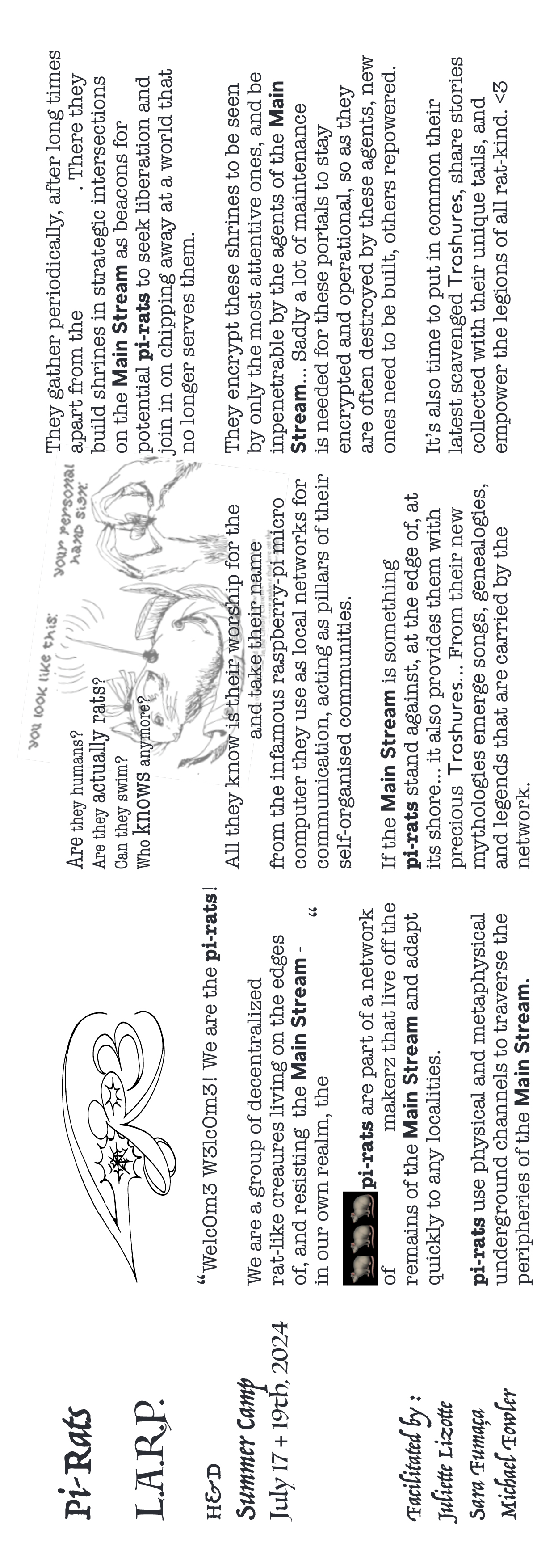
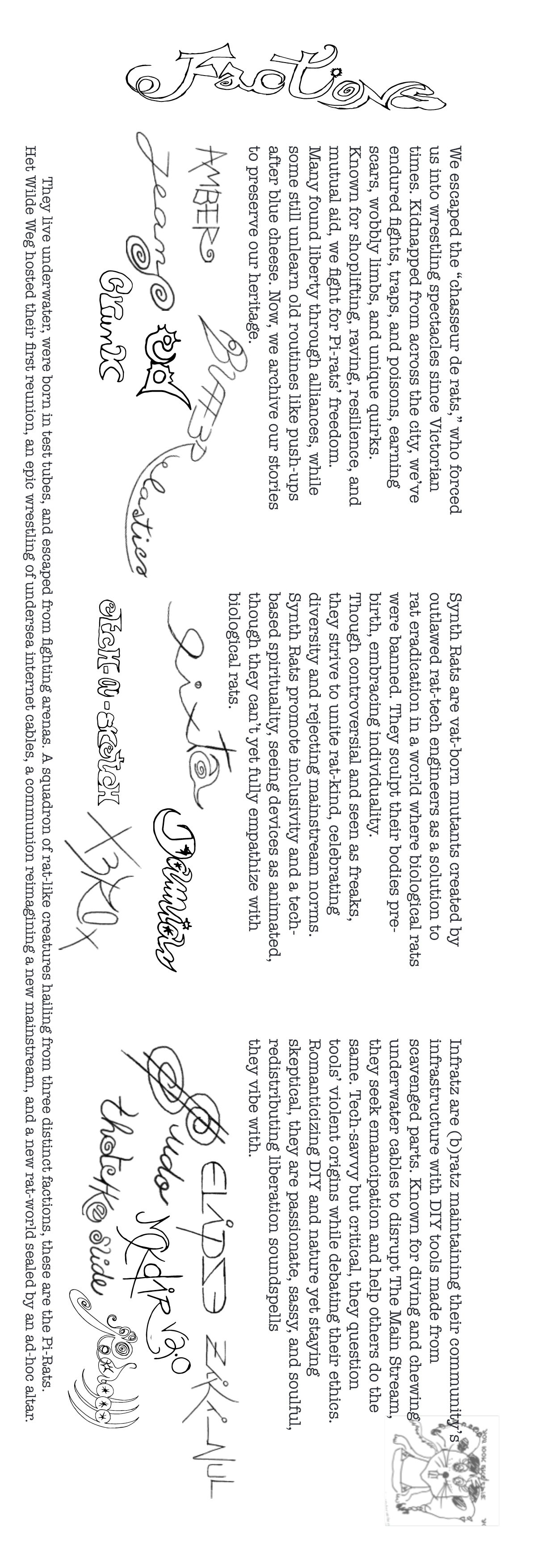
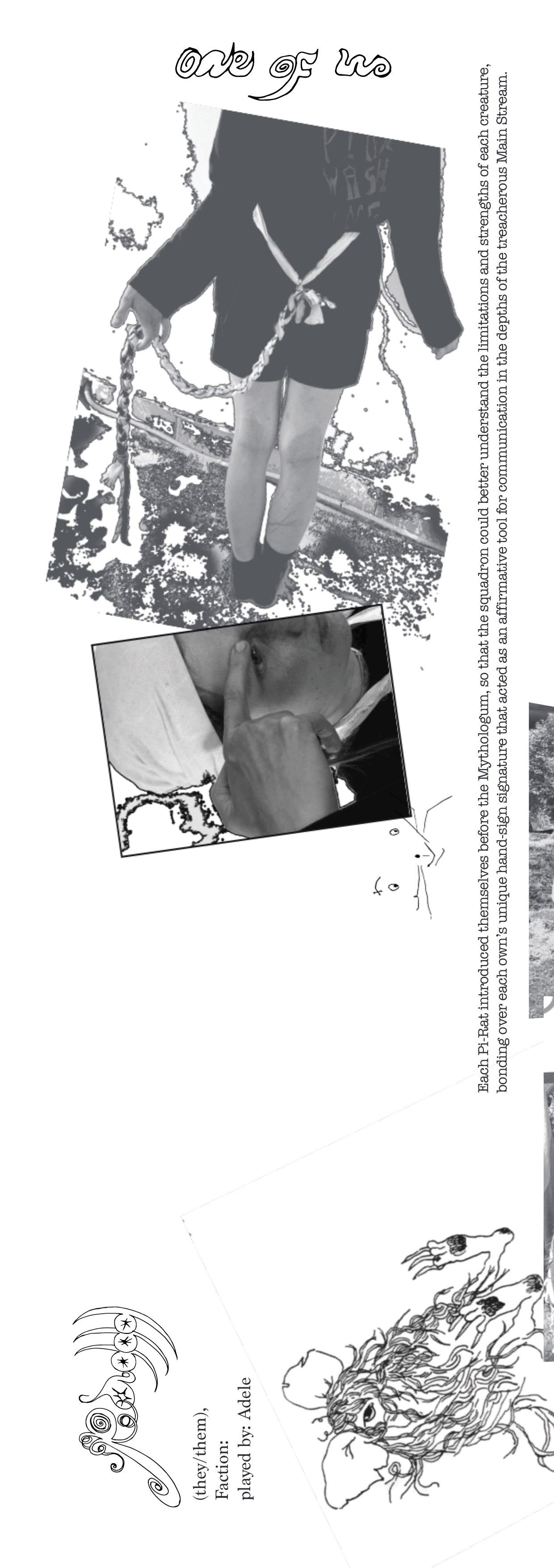
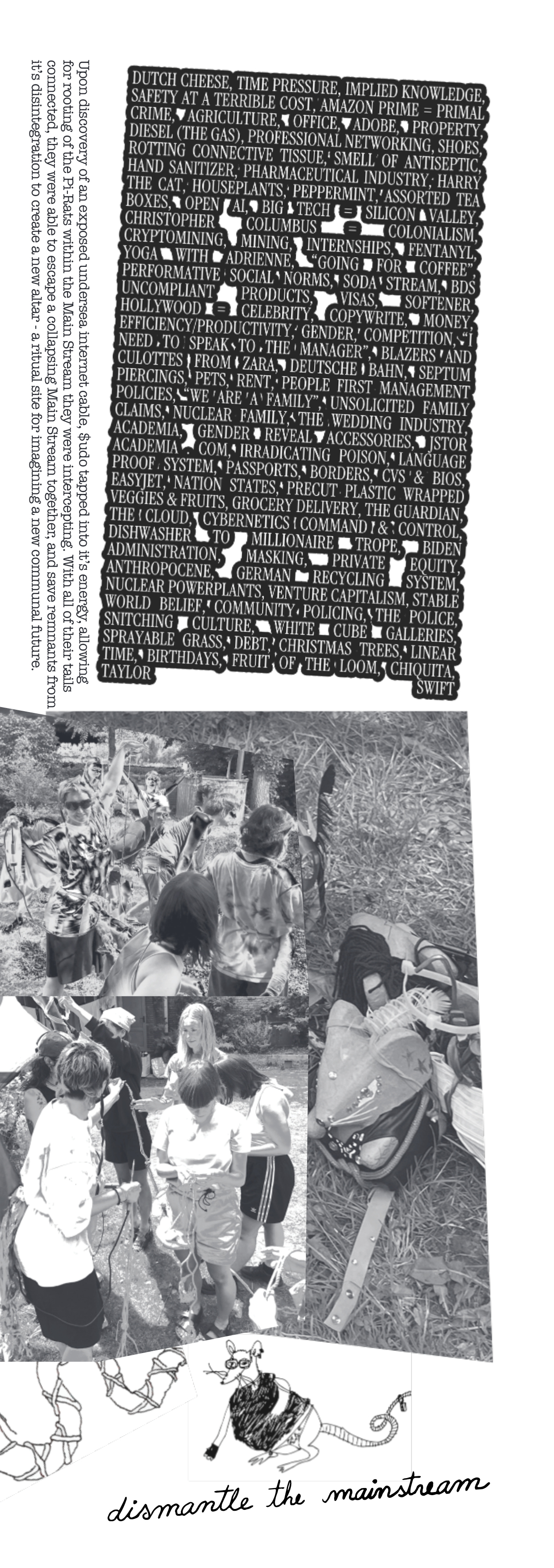
Draw-it-with-others
・゚゚・。Chae & Kamo - DIWO Working Group *・。・゚゚
For the H&D Summer Camp, the DIWO Working Group, prepared a series of small morning activities with some breakfast and drawing materials. Participants were invited to stretch their body-mind through a series of drawing prompts (while having coffee!).
Over the course of 10 days of camp, these appointments became part of the routine: waking up, brushing teeth, going for breakfast, receiving a drawing prompt. Thanks to its simple format6 we were able to support different forms of engagement and participation. Sometimes it would take place in a small group at a tiny table and other times more than 30 people joined, aided by a live projection. Every activity was proposed with a “Drawing Prompt of the Day”, printed on the fly with a receipt printer (kindly borrowed from Manetta Berends! Mega thank you!) Each prompt came with a title, a cute illustration, a description, some steps to activate it, and references or a backstory on how the activity had sparked our interest.7
All the activities brought us many memories and insights. Here’s a list of prompts and things we learned along the way:
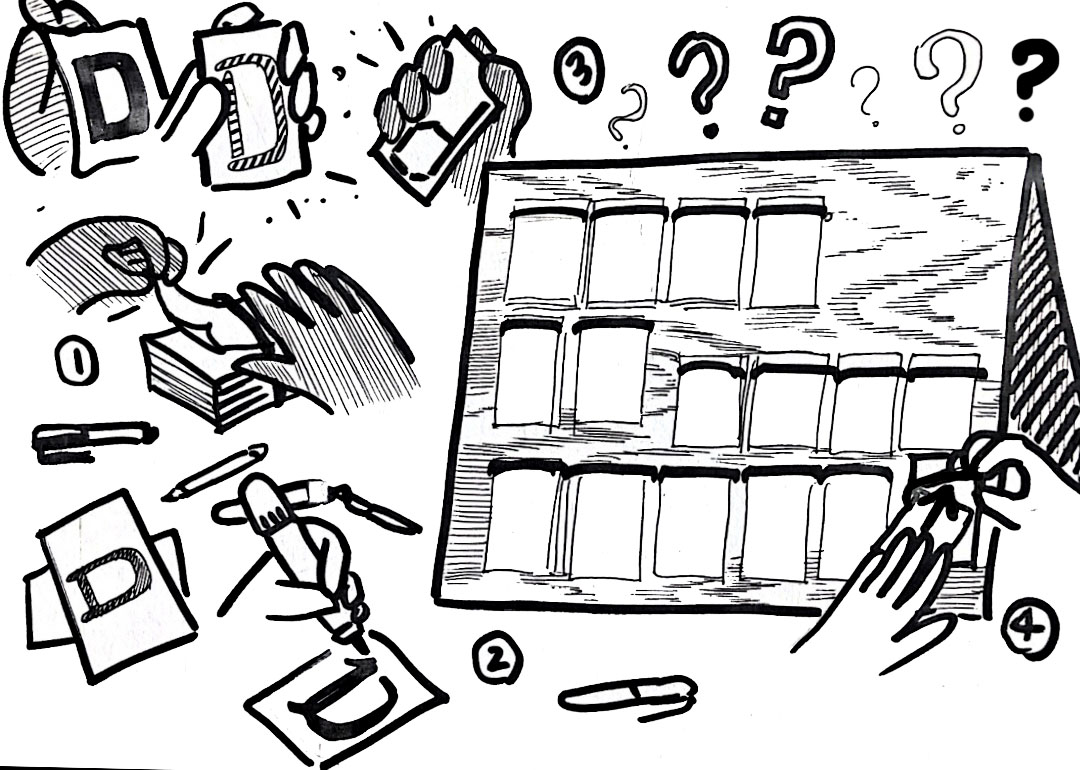
People were invited to draw one letter and append it to a dashboard we built for the workshop, slowly versioning the characters of “Draw-it-with-others”. It followed the DIWO activity every morning. It functioned as a tool, an installation, a workshop… creating space for multiple ways to activate a process.8
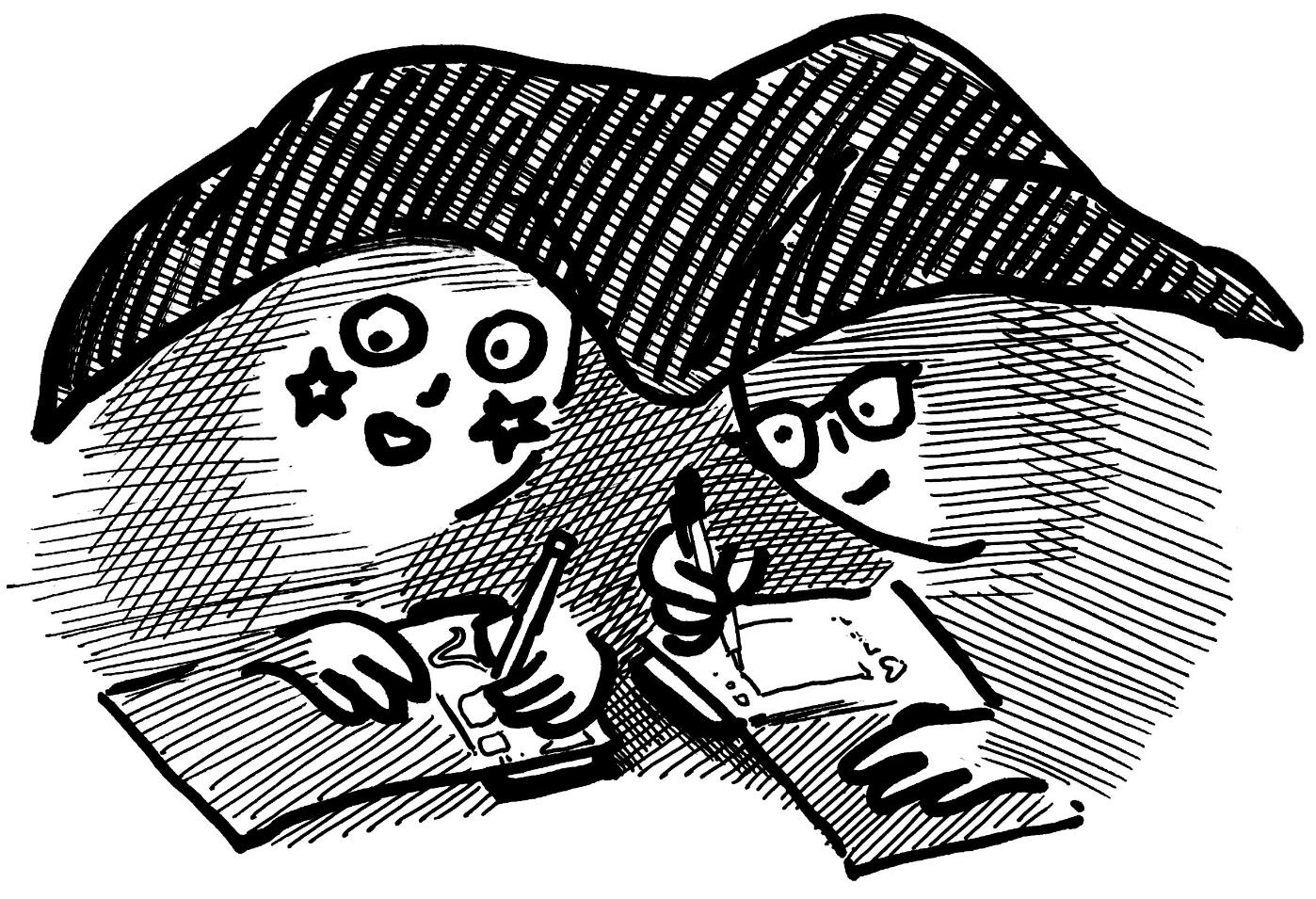
Screenshots are an interesting image format, rich with intimate narratives. We proposed to participants to trace the display of their smartphone. We also suggested they exchange their phone with someone else, to stay with the vulnerability of sharing such personal device with others.
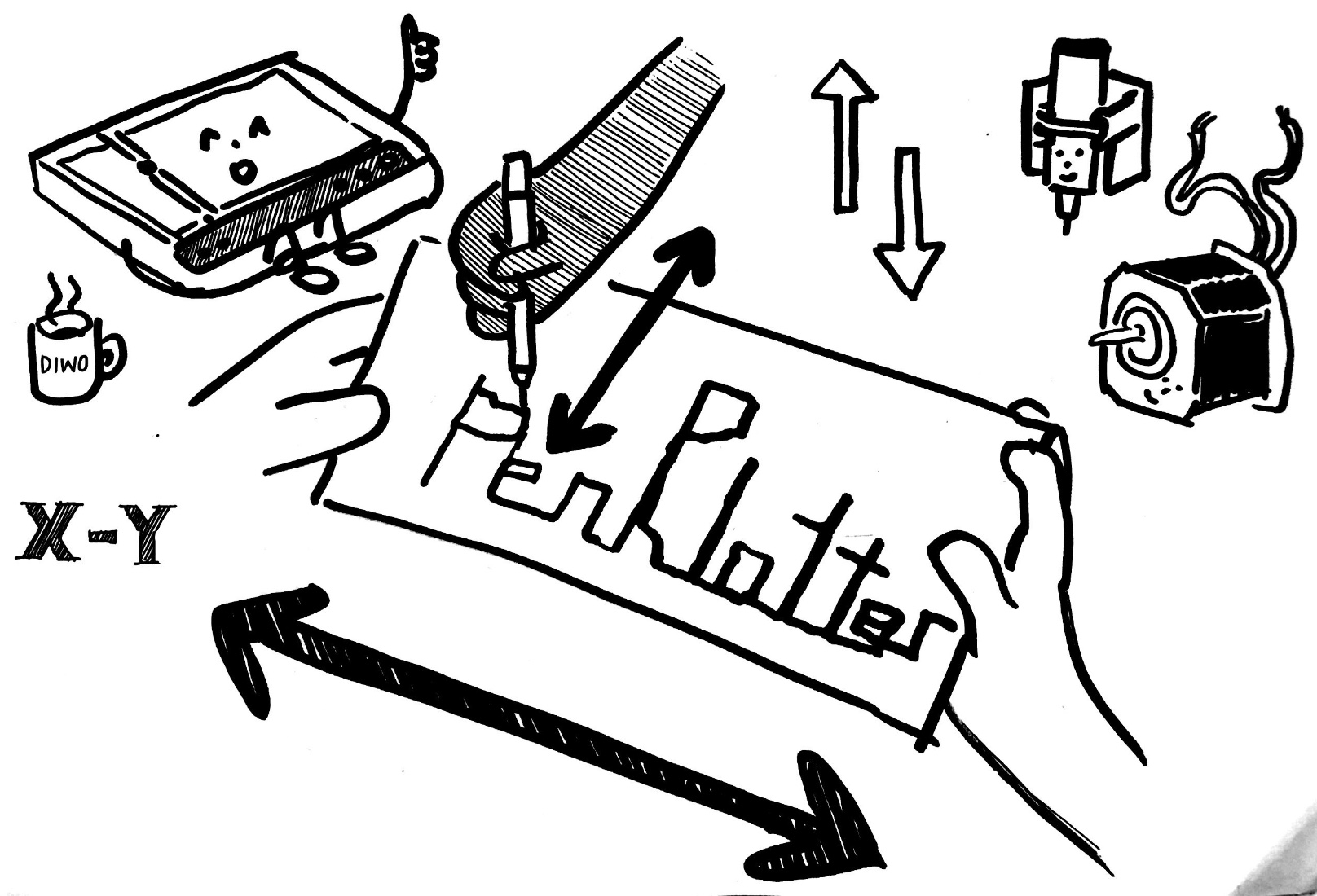
Before the summer camp, H&D facilitated a peer review process for the program. We reached out to Adèle who was planning to work with their pen-plotter.9 Inspired by their activity and intercepting a general interest in LARP practices at the camp (Chatty-LARP10, Pi-rats Mythologum11), we invited groups of two people to transform into plotters. In this way, people could get an insight of a complex tool by taking on the perspective of the tool itself. It is a way to let them familiarize with a machine before diving into its technicalities.
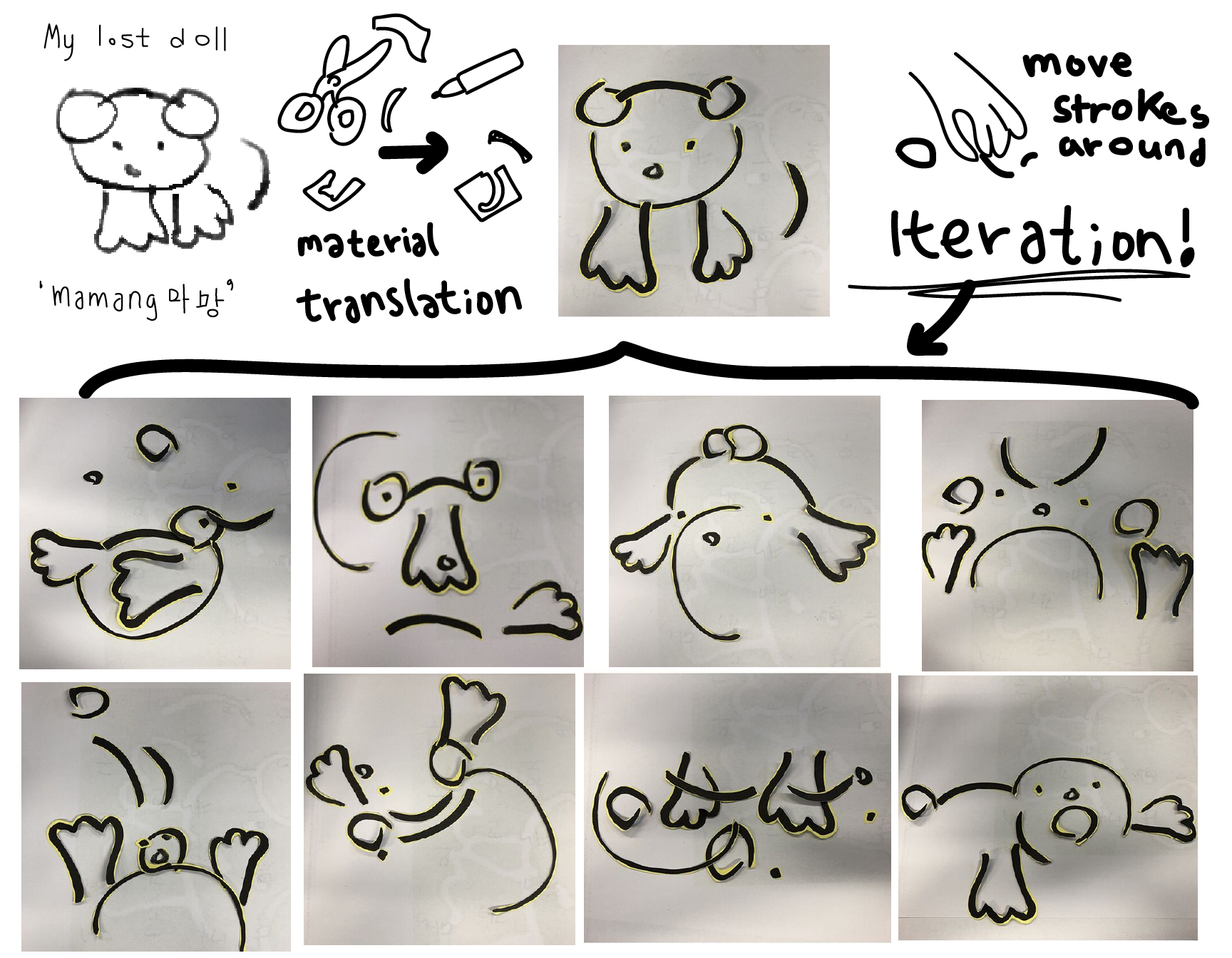
SVG-re-draw was the first custom software we proposed at the camp.12 People could scan a QR code on the prompt, that linked to a SVG drawing by someone. They could reposition the strokes, moving and rotating them to compose another figure, then send it to someone else for another re-draw. We were interested in the way authorship would blur when multiple users/creators are involved in using the tool. We prompted the prompt, people connected to the website, spent some time re-drawing and hit send.
…And it didn’t work.
Developing web app is always a pain, because each browser behaves differently. What Chromium likes, Firefox doesn’t. Then comes Safari, which does everything in its own way. To complicate things even more, we were targeting mobile browsers. When we finally managed to support all of these, the server crashed. It was disheartening. It was a tool meeting users for the first time, and that rarely goes as planned.
Looking back, we realized that ‘the tool not working’ could have been a moment to treasure: an interruption to the logic of software-as-product that creative clown industries have made us used to. A moment for others to participate instead: to share joy and mourn together errors in production. Debugging as a collective ritual? Sounds nice. (We still have unresolved feeling about this prompt, at least Chae does.)
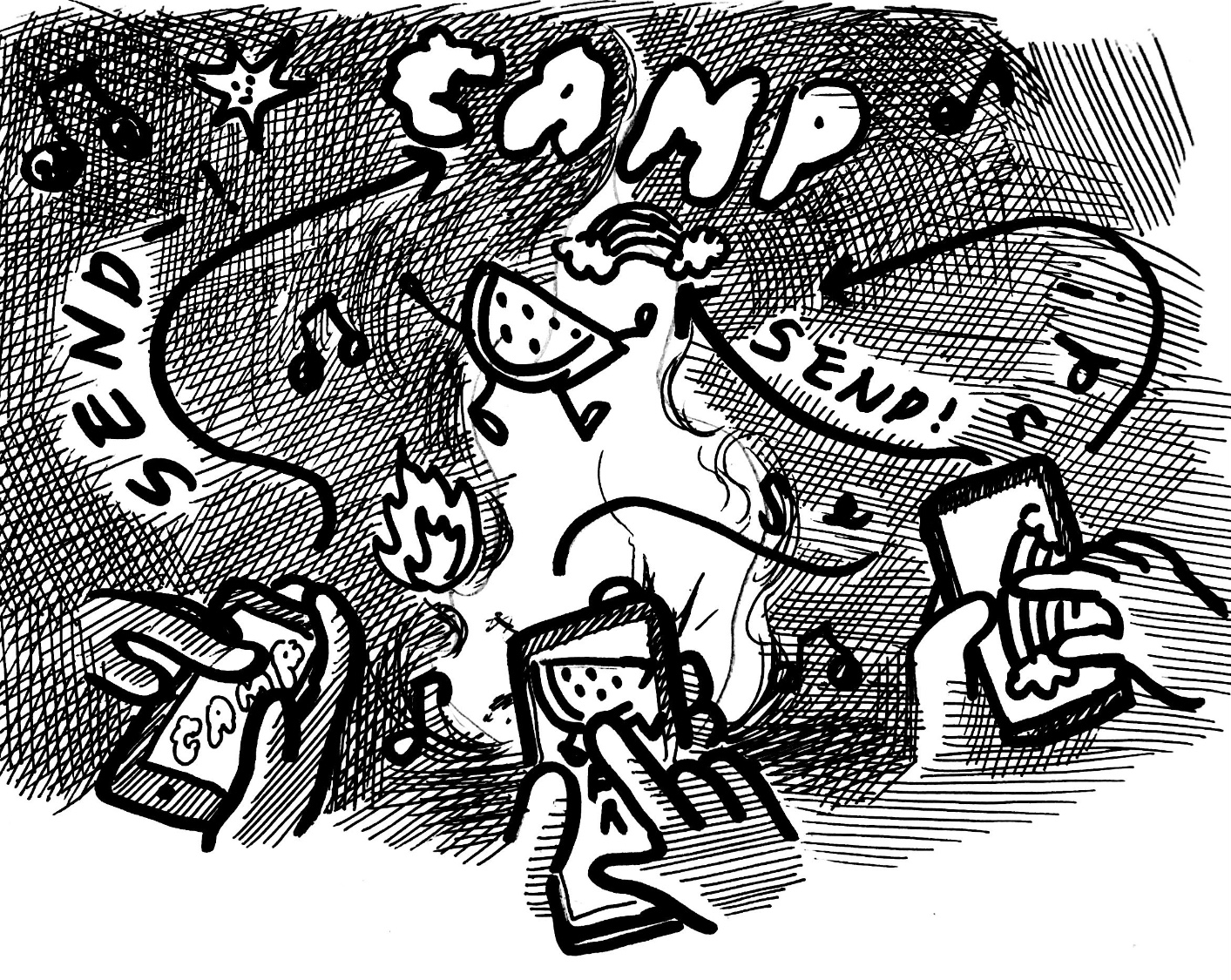
During the radio show we tried another small piece of software: drw13, a WebSocket server to receive drawings from connected users. Gathering to recall the events of the day turned out to be the best setting for such activity. Funny feedback loops happened between what was being said/broadcasted and what was being drawn.
People (in the radio barn and from elsewhere!) were sending drawings which were displayed on the H&D homepage with help of Karl, and received on the Diwoboat (our server) where all drawings were stored for future re-use.14 Kamo was animating them in real-time and projecting them on the barn of the radio booth. A small ecosystem of situated software: not a single centralized program, but rather a network of different pieces interacting in their own ways.
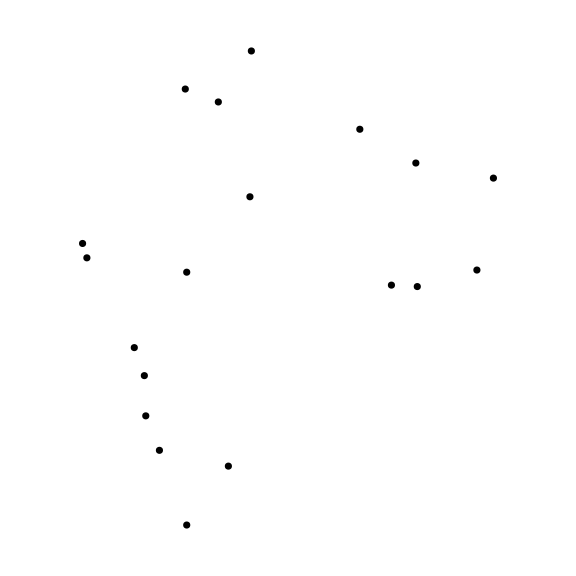
We tried to re-use the drawings sent during the radioshow with yet another DIWO tool: a connect-the-dots puzzle generator. To our immense joy we managed to plug the pieces together, and connect our Markdown-to-receipt renderer. This was one of the moments we felt that the previous three months of work paid off. It felt like tending to a small garden, and it inspired us to keep working with the idea of open endings and interdependencies of tools. (The source drawings were carefully selected for each H&D participants and given as a goodbye gift.)
・。・゚゚・゚゚・。
For a more documentation about the prompts please check our website15 and repository16!
A final note about the DIWO Working Group: Chae and Kamo are using this name, but feel mega free to reach out, fork the software, add prompts, prototype tools, share references, and more! Let’s draw together…!
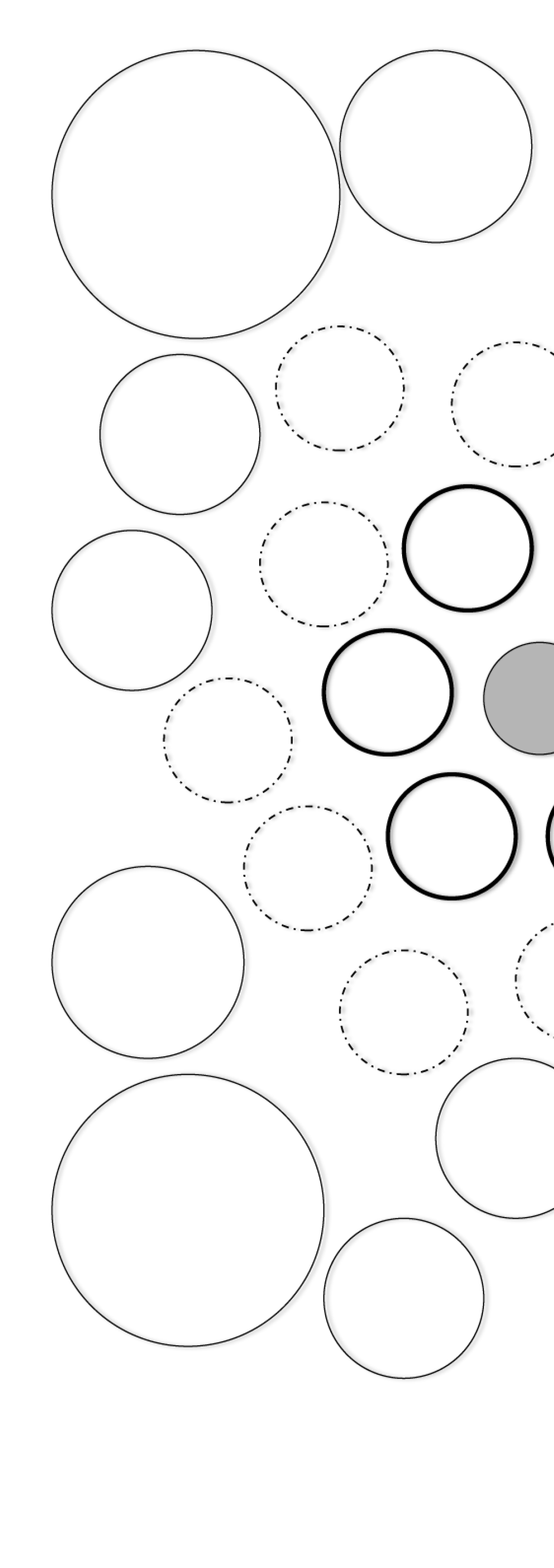
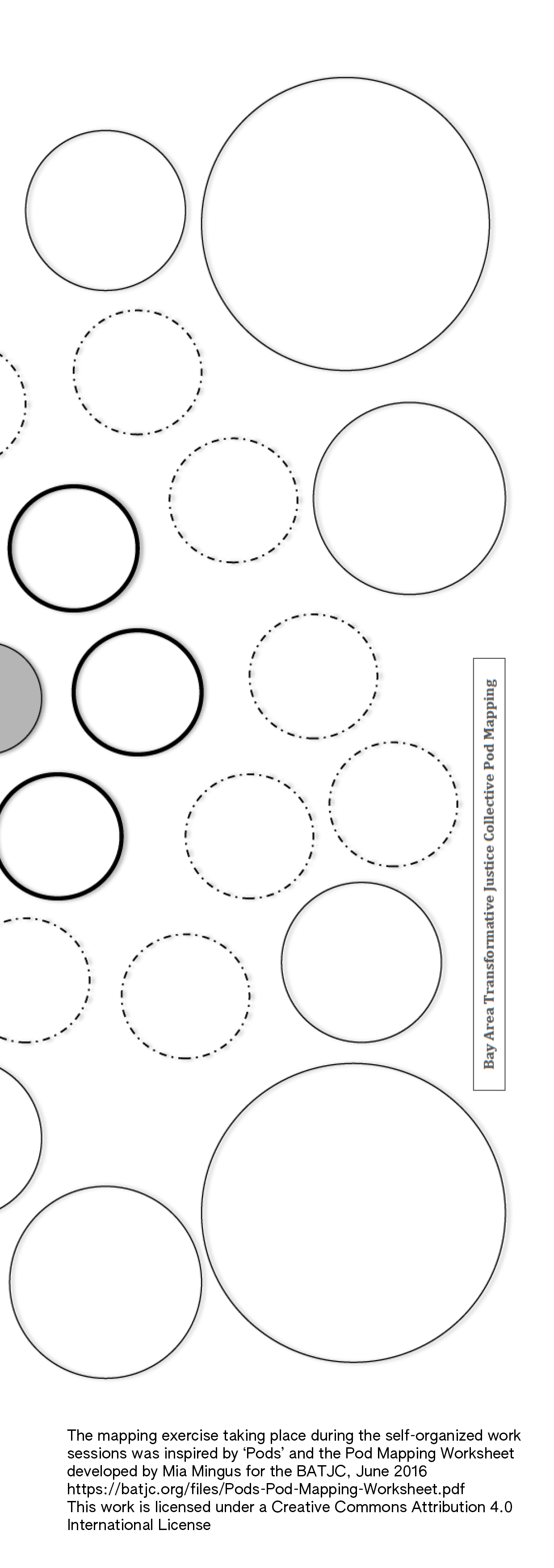
Self-organized
・゚゚・。 H&D *・。・゚゚
Self-Organized [re]work session {(1)}: “Breaking the Organigram”
・゚゚・。 slvi.e *・。・゚゚
Sarah Payton has decades of experience in feminist collectives and used to work as a community organizer at Art City NDSM in Amsterdam. She spoke about her involvement as an active citizen over the past fifteen years in different phases of this artist and maker community in the NDSM Loods. The building, also housing the H&D studio, is a 100-year-old shipbuilding warehouse, and the idea to make studios here began 25 years ago when the local authority issued a competition for ideas for the then vacant shipyard.
Sarah reflected on the transition from idealism to a complex reality where financial pressures and institutional entanglements challenged the core values of collectives. The original dream was to start a community of artists and craftspeople in the north of Amsterdam, in an area that was – at the time – perceived as an urban fringe far from the city center. Perceived to be far from the city center. The community would build their own studios – the ‘art city’ – and would run the building themselves. However, funding conditions required the community to implement certain organizational structures. The pioneers were pressured by local and national government bodies to bring in outside supervision (who supposedly would be better equipped to take on responsibilities). What was intended to be a self-managed artist-run space became increasingly less so over the years.
Sarah: “Today, there’s a community of 200 people. Half of them have built their own studios; 1/4 are middle-long-term residents, and 1/4 are new. We pay rent to the foundation that owns runs the building, although we once set it up ourselves, as tenants we have had little say in how things are done.” For the past 20 years, there have been many efforts where the community has come together to try to regain influence over policy and re-establish core values for what we see as our building, but mostly these efforts were unsuccessful. Now things are changing, with a new tenants council that has greater formal influence. “The council is working with building management and tenants to write a policy and vision document – the first in 20 years”. And we are actively involved in the process of finding a new director” (as the current one will step down in 2025).
Referencing political philosopher Wendy Brown, Sarah pointed at he relationship between democracy and community. “You need community for democracy to work,” she explained, “not the other way around,” stressing the importance of sustaining spaces where alternatives can still be realized, even if their potential is not immediately clear.
Taylor leMelle, co-founder of not.nowhere, shared a story that exemplifies the complex dynamics of inheriting tools and legacies. The equipment at not.nowhere (16mm and Super 8 cameras, Steinbeck editing tables, and film archives) has a long history. It was passed down from nowhere, a now-closed non-profit funded by the Arts Council England. After the organization had to shut down, they offered not.nowhere their equipment. This moment of inheritance became a turning point for the group, forcing them to confront whether to professionalize to manage resources and sustain their work, or preserve the informal, self-organized nature of their collective; the group was informally organized and called C.R.E.A.M. until that point.
Those interested in becoming an organization started a legal process against the Arts Council England to let nowhere give them their physical assets (including the funding which they argued activated the physical assets). That’s when the name not.nowhere was born.
To the question whether the equipment entraps the collective, Taylor answered, “It’s a gift and a burden. We’ve inherited all this analog equipment, but repairing it requires a lot of time, knowledge and negotiating with people who live in an entirely different world—some of them don’t even have mobile phones … It’s a beautiful place to be in the Venn diagram.”
For Taylor, this equipment, while very valuable, symbolizes the tension between progress and failure within post-industrial art practices. “It’s impossible for us to ‘succeed’ in a traditional sense,” they explained. “These machines require time, patience, and a relationship. It’s a slow process, and there’s something beautiful but opaque about it,” Daniel explained.
The dialogue of the session emphasized the intricate relationships between collective practices and external pressures, particularly the role of funding in shaping modes of organizing. Sarah was vocal about the dangers of funding dependency, particularly when collectives start to compromise their values in pursuit of financial stability. This echoed Taylor’s frustration with the legal and bureaucratic hurdles not.nowhere has been facing in their efforts to secure funding from the British Arts Council.
The session concluded with an exercise to rethink traditional organizational structures as represented by the organigram. This diagram is typically defined by hierarchical relationships and strictly defines borders between different tasks and responsibilities. It imposes as a rigid framework. How do we confront the need for institutional and economic renumeration while remaining true to the fluid nature of self-organization, and making that more messy reality of collective work legible? The exercise proposed Mia Mingus’ pod mapping technique19 as an alternative to the rigid organigram.
We proposed to participants to put themselves or their collective or organization in the middle of the map, while reflecting on the question: “Who and what do you need in order to function as a collective as well as an individual within the collective?” Participants began mapping their personal support networks, highlighting that collectives are porous structures that are interdependent and respond to changing conditions.
Self-Organized [re]work session {(2)}: infrastructural explorations
・゚゚・。 slvi.e *・。・゚゚
systerserver20 is a trans*feminist affective infrastructure collectively run and maintained by queer and feminists technologists, researchers, activists and artists. ooooo shared the story of how systerserver grew out of ASCII, a hackerspace in Amsterdam, and the need for a woman-only space to learn about technologies. ASCII, much like the majority of hacker/anarchy environments in the early 2000s, dominated by cishet males. From this, Genderchangers Academy came into existence, and started co-organizing Eclectic Tech Carnival21, a self-organized skill sharing event. During this gathering, they started systerserver, a feminist server.
“What is this feminist server that we are using as a concept? Because, of course there are different ones,” ooooo explained. “We approach feminist servers as emancipatory spaces for activating feminist pedagogies: doing it together, being in safe spaces of queer, non-binary and trans folks, documenting thoroughly, and creating space to study. Instead of thinking purely of a server as technical infrastructure, we approach it as affective infrastructure—one that organizes the relations around it.”
systerserver’s recent project 360 Degrees of Proximities22 highlights both challenges and strengths of a feminist server. The systerserver collective installed and configured PeerTube, an open-source alternative to mainstream video platforms. “It looks like a ***tube, but it’s a PeerTube. Federation was key here—not being our own isolated server but thinking through federation as both technical and social protocol.”
“At the moment, our peertube instance’s23 quality of video upload is 720x576px. Nowadays, 8k is common, I guess; and below there is 4k. These are really questions we try to think through: the politics of resolution: do you really need this resolution, or can you just go and see for yourself? We have an iconoclastic approach. These are very resource-eating pixels. It’s important to evaluate what people commonly think of as very low quality.”
However, sustaining this work remains fragile. systerserver does not operate under a formal organizational structure capable of receiving funds. “Most people sustain themselves. It’s precarious, and sometimes it’s a challenge.” Yet they resist defaulting to extractive models, insisting on rethinking the ways infrastructure and economy intertwine.
In dialogue with systerserver, Luke shared insights into Permacomputing.net. Permacomputing is both a concept and a community of practice, Permacomputing(.net) centers issues of resilience and regenerativity in computer and network technology, drawing inspiration from permaculture.
“If you Google permacomputing, you’ll find a wiki—a sound bite of the overall project, really an invitation to critically rethink computational culture today. There’s a lot of technical information on the wiki, but it’s a work in progress.”
The “perma” in permacomputing refers to “permanence,” borrowed from permaculture. Luke posed a central question: Can permacomputing do for computing what permaculture did for agriculture—promote sustainable and self-sufficient ecosystems? Yet the paradox remains: “With permaculture, you observe and see how you might fit in. With computing, you are already part of a supply chain and a very specific industry. Production and mining have already happened, and main circuits of digital distribution and consumption are unavoidable. You can’t escape that, but you can choose how to critically engage with that and what kind of responses can be made to start design other ways to engage with computational culture.”
What does this look like in practice? A quote from the Computing within Limits conference captures the essence:
“At a time when computational culture seems to be increasingly characterised by electronic and energy waste, permacomputing instead encourages a more sustainable approach by maximising the life of hardware, minimising energy consumption and focusing on the use of already available computing devices and components.”24
Permacomputing.net began with an exchange between Ville-Matias Heikkilä—who coined the term in 2020—Marloes de Valk and Aymeric Mansoux. Frustrated by the lack of visibility of counterpractices to Big Tech, Ville-Matias had started publishing online a small collection of random thoughts describing what could be permacomputing, Marloes had begun compiling a list of collectives and expressions resisting dominant systems, and Aymeric was involved in different projects related to community servers, art and ecology, and proposed they build a wiki together to further explore and articulate what permacomputing could be. They announced the project on the Fediverse in June 2022. In the past 2 years, the wiki has grown to 30-40 contributors, and became central to the development of a decentralized and distributed community. Events are happening in Rotterdam, Utrecht, Philadelphia, Strasbourg, Berlin, and beyond. Chatrooms and online forums pop up here and there, projects are initiated referencing the wiki. Some are initiated by people involved in the wiki, others are not affiliated. However, “as visibility grows, we have to ask ourselves: Who are we? What do we want to do? And what influence do we want to have?”
Luke emphasized the invisible labor sustaining this infrastructure: “There’s ongoing moderation work—on the wiki, in chat spaces, and beyond. We’re careful to avoid becoming a deluge of tech bros. It’s work to keep this space diverse, thoughtful, and intentional.”
The session offered a rich dialogue between these two forms of self-organized infrastructure, both questioning and actively countering the assumptions of Big Tech while embracing the complexities of building alternatives. Through their work, systerserver and permacomputing reveal that infrastructures are never neutral. They are deeply embedded in the values, politics, supply chains, and relationships they create. The hardware of infrastructures remains stubbornly embedded in extractive systems. Yet systerserver and Permacomputing are communities of practice demonstrating that even within these contradictions, alternatives can be carved out. Their work embraces the arduous and precarious task of building and maintaining otherwise, turning servers into political spaces, spaces of care, negotiation, and experimentation. These projects do not resolve the tension, but they refuse resignation, reminding us that we can hold space for collective survival and radical imagination—even as we reckon with what sustains the machine.
Principles of permacomputing.net https://permacomputing.net/Principles/ For more context on the development, this article Things can break: Tech woman Crashing Computers and Preconceptions by Aileen Derieg is useful and was discussed by ooooo https://transversal.at/transversal/0707/derieg/en Feminist server manifesto https://areyoubeingserved.constantvzw.org/Summit_afterlife.xhtml
Self-Organized [re]work session (3): alternative economies
・゚゚・。 Anja *・。・゚゚
H&D has been an experiment in self-organization since its first inception in 2013. In varying formations from 3 to 9 members, H&D has been mostly organizing ad-hoc workshop-type activities that take a hands-on approach. With a critical yet optimistic attitude we like to reimagine socio-technical relationships, forms of working and living together that are non-extractivist, regenerative and proof alternative to Big Tech’s paradigms over commodification and endless expansion.
H&D activities have been funded since 2015 by various Dutch cultural funds. Throughout the years, we’ve sustained a certain collective awareness and critical reflexivity about H&D’s evolving dependencies on these types of funding. For instance, a question that is recurrently surfacing is: How come we organise event-type activities? While we enjoy coming together with peers, the pressure induced by receiving public funding to attract audiences has been tedious. The question: “How do we organise, and how are the economies we are enmeshed with organizing us as a collective?” has been the starting point for initiating a focussed session on the economic underpinnings of self-organization.
The third and last [re]work session on self-organization was co-organized with Platform BK as part of their Collaboration Station25 at De Appel in Amsterdam and brought together various perspectives along with inventive economic schemes for collective organization. H&D invited three guests to reflect on the urgency of [re]thinking and [re]working the economic conditions of cultural work. Kate Rich who joined online, Benjamin Earl and Kuba Szreder shared their experiences, approaches and modalities from their involvements in various self-organizations operating between art, activism and community building.
Within the art and cultural sector, self-organized collectives frequently contend with precarious conditions, including reliance on state funding. Undoing and redoing economies means going against the grain in a lot of ways. It often takes more work, more time, more effort, more energy. Yet, as we have seen in the presentations, these endeavors can simultaneously provide pathways to resilient and self-sustaining practices that succeed in creating space and time to do things differently than the mainstream.
Kate, who is an artist, a trader and feral economist, runs Feral Trade since 2003, as a business and art project at the same time. She uses the surplus energy of other people’s movement (especially in the art world) as a freight surplus. When she started with Feral Trade, there was no gig economy yet, no blabla car. Feral Trade wasn’t about efficiency. It was rather about slowing things down. Kate: “I was running the business as a sole trader”, mixing the economy of art and trade.
Practicing alternative economy seems to involve rethinking and reshaping economic models in relation to existing systems. These alternative models are highly contextual, evolve within and respond to the specific circumstances and conditions.
Collective organizing often involves diverse socio-economic realities, where members navigate varying pressures, such as presenting financial stability to secure legal status. Sensitivity to these differences is vital, and approaches rooted in collective care—financial, emotional, and energetic—become essential. Exploring models that address such complexities are prerequisite for creating inclusive and equitable practices.
Kate set up the Feral MBA26 to bring people together to try and think about business, money and survival, and learn from each other. She sees the feral MBA as “proudly DIY” – a tool to unlearn, and challenge the idea that the economy can only be one way. In the context of this program, Kate has been considering the budget as an art work in itself. The budget is an artifact, a technology to think about business and economy differently in the way it is presented. The budget also appears as a piece of merchandise. It is printed with care and sold as a souvenir at events to be taken home.
Alternative economic practices and structures are inherently context-specific, yet sharing knowledge and best practices can foster innovation and collaboration. Discussions about growth, and professionalization also play a role in shaping these practices. Addressing pressures to expand or generate more and more income while remaining true to core values requires careful consideration.
According to Kate, the question of scale is a multilayered and invasive one. She asks: “How do you keep out of scale’s malignant reach?” The assumption of scale (which assumes scaling up) as the direction for everything is a very strange one . It was interesting to watch an organization such as the Cube Microplex stay the same size over many years. The Cube is a volunteer-run music/cinema/art space in Bristol. It makes all its income from the door and bar. Kate was working there for many years, in roles from bar manager to banker, drawn there by an organizational ethos that was ad hoc and self-invented. “We all learnt on the job.” The Cube is legally constituted in the form of a coop and community land trust, which came together to buy the building. “The purchase was peripheral to the sense of ownership we had of the business. You could pretty much walk in from the street and become a director, and many people did.” About 150 people run the Cube at any one time.
“For me, these durational experiences I had of running Feral Trade and working as part of the Cubewere a way to move away from needing to understand this huge thing – the economy as a whole - to working with business as something that it is actionable, sizable, a way to navigate the economy, hands-on”27
The external presentation of self-organized collectives sometimes diverges from the lived experience of organizing. Balancing these realities while maintaining transparency and coherence can be challenging. The structures and formats through which collectives operate—whether as cooperatives, foundations, or other legal entities—carry significant economic and social implications.
Bnjmn Eearl, researcher and designer, whose work is mostly focused on and intertwines different social / political paradigms within digital culture. Bnjmn’s practice is an example of how working collectively means being part of many things simultaneously. He is part of Extra Practice,28 runs Good Times Bad Times,29 member of Varia,30 and works at the Het Nieuwe Instituut31 as a researcher.
Bnjmn talked about the different collective spaces he’s part of and how they maintain themselves. He referred to the practice in such spaces as an ‘ecology’ rather than an ‘economy.’ Bnjmn gave us insight into collective organization from the vantage point of one person navigating these various more and less formalized spaces simultaneously, some of which are funded through projects, some receive structural funding from the municipality or cultural funds, and others are completely self funded. Harriet (Platform BK) asked Bnjmn how he navigates working together within financial realms, dividing money, finding agreements, ways of working. Bnjmn responds that every single one of these spaces/groups is chaotic. “It’s a constant and messy negotiation between all these people, whether it’s about funding, housing corporations. There are many moving variables. The work that goes into this type of organizing is not always smooth. But there is a commitment to trying to find ways that everyone feels good with what they’re doing.” He adds: “I don’t know how it all works at Varia, for example. When I joined, I had to learn to let go of the need of having to have oversight.”
We have been introduced to a spectrum of possibilities for transformative action, evolving from grassroots organizing and practical methods for rethinking and redoing economies. A question that remains is: What are meaningful ways of sharing alternative practices/structures for sustainment across different communities and contexts without becoming prescriptive?
Kuba together with Kathrin Böhm initiated Plausible Economies in 2018.32 Plausible Economies brings together artistic action and critical thinking to reclaim the economy. It is a platform for mapping and reimagining economic systems, in the arts and beyond. With the Center for Plausible Economies. Kuba furthermore published the book “The ABC of the projectariat”.33 This book is based on Kuba’s 20-year experience of freelancing in Poland, squatting in Amsterdam in the 90s and living in the eastern borders of fortress Europe. Kuba reminds us that there is no single answer to the question we asked him in preparation for the session: “How do we get from imagining alternative economies to implementing one?” It is commonly known, living and working in the art world is precarious. According to Kuba, in Poland, most artists live below minimum wage. “If we account only for the artistic labour, it’s even less. Life in Eastern Europe is not cheap, there is a housing crisis. 90% of artists in Poland work in either self-employment or in precarious zero-hours contracts. We do not have access to social / health security systems.”
One of the entries in Kuba’s book is about unionization, which is one way of answering the question. Kuba proposes that “unionizing is a way of approaching the question of minimum wage. We cannot take for granted that artwork is labour. We have to keep reminding ourselves there are many assumptions about this labour as something that doesn’t need to be paid for.”
Throughout the session, it became apparent that the types of practices discussed – because of their highly contextual ways of doing and organizing – are always getting isolated and marginalized. Thus, the question remains: how can we share and ensure that these types of situated practices and knowledge spillover into akin communities? Kate commented “In this event you are bringing administration to the forefront. Making the time and space to come together and share these practices, which are normally treated as background processes is really important. To build new solidarities, while also allowing for all the differences.”
Postscript: In the second part of the session, H&D invited participants to work with their own experiences and questions around self-organization and alternative economies by means of an individual mapping exercise that we had already explored in previous sessions. The exercise aimed to encourage participants to reflect on and reimagine how labour, care, and infrastructure are organized within their practices, with the goal of fostering community well-being and strengthening allied networks. This part of the session was not documented other than the personal maps that were created, which participants took home.
Boiler room Inspections
・゚゚・。 Erica Gargaglione *・。・゚゚
Dear Hackers & Designers,
With this letter, I hope I will be able to pick up on your [Re]work sessions—the meet-up series on self-organization—particularly the one about infrastructural explorations. Simultaneously, I’d like to contextualize the Boiler Inspection form attached here. The latter, a tool originally developed as part of my master’s thesis, is now being recirculated at your suggestion—which I deeply appreciate.
I must admit that when you invited me to contribute to the bulletin, I was met with mixed emotions. On one hand, I was paralyzed by a good dose of reticence mixed with a taste of impostor syndrome—an ever-present doubt that makes me hesitant to produce any type of content able to materialize a consistent and measurable artistic practice. On the other hand, I felt an undeniable urge to engage in honest conversations, scratching the surface of alternative forms of collective work engaging with collaborative tools and “solidarity (digital) infrastructures”. Topics that deserve to be talked about much more.
At the very beginning of the meetup, Anja raised a crucial point when talking about the feedback you received on part of your funding application: the funding body commented that the self-organized rework sessions ran the risk of being “too self-referential.” A critique that reflects a broader tendency within the funding framework to measure successful initiatives with scales that don’t take into consideration the value of internal processes and experiments focused on intimacy, care, collective learning, and autonomy. These are all fundamental for the functioning of a self-organized collectivity; self-organization itself is the necessary collective labor that allows to organize other activities in turn. It’s sad to ascertain that funders seem to be blind to such necessity. By not supporting your approach, they also hinder other groups inspired to experiment themselves with self-organization as both the method and the object of their artistic practice. The consequence, brought to its extreme, is that they end up isolating and marginalizing even more self-organizing practices that really try hard not to be self-referential. And actually, what does being self-referential mean when the amount of participants is what matters in the equation for success?
Within the current wave of budget cuts in the cultural sector, funding schemes exacerbate a model of scarcity, where cultural workers are constrained to compete with each other as single units and adapt to a game that is more and more difficult to navigate—especially for art and design practices operating on the thin line between niche and perceived self-isolation. That self-organization is externally received as self-referentiality is a hypothesis that I’m making, but if that’s true, then we deserve better questions. We deserve questions that facilitate a deeper troubleshooting, rather than disregard the need to break away from a paradigm that fails to support meaningful work and non-extractive relations. How do we maintain spaces where alternative forms of organization and cultural production can be developed and practiced? And how do these practices connect to communities rooted in reality rather than in seasonal cycles of grant writing? Whenever I reflect on these questions, a passage from Jo Freeman’s The Tyranny of Structurelessness, refrains in my head:
…diffusion of ideas does not mean they are implemented; it only means they are talked about. Insofar as they can be applied individually they may be acted on; insofar as they require coordinated political power to be implemented, they will not be.
Organizations like systerserver and communities exploring permacomputing practices—which were hosted during the second Rework session—elaborated on ways of reclaiming agency over their organizational flow, embracing self-care and practicing principles like “keeping it small,” even if that implies becoming less legible to external systems. They do this while trying to implement and maintain the very socio-technical infrastructure that makes their work possible, in a way that resists traditional forms of professionalization. If this is what self-referentiality entails, then we must reconsider its potential. In a dominant framework that prioritizes the diffusion of ideas—measured by “documentable” outcomes —over their implementation, self-referentiality becomes a political act.
If there is anything that I would point out in terms of quantity is the only fact that your meetup series and other events like yours reveal the significant number of cultural workers and organizations who share similar struggles around self-organization. A hidden niche whose rhizome extends much more than how it is perceived, partly because much of the work of self-organization happens behind the scenes. By nature, the labour required to create and sustain protocols and infrastructures is invisible, yet it demands tremendous effort to ensure that self-organizing initiatives operate smoothly and sustainably in the long term. As one of you pointed out during the event, it remains unclear whether self-organization is a form of resistance, or a symptom of precarity—or both.
To conclude, I’d like to briefly return to the Boiler Inspection mentioned earlier. This tool consists of a questionnaire intended to facilitate conversations about the maintenance of a collectively used infrastructure, whether physical or digital. The intention is to create an escamotage that externalizes difficult discussions through role play. By impersonating the boiler inspector, it might become easier to address and articulate financial, mental, or affective struggles, especially in contexts where radical friendship is at stake.
I’d be delighted if you choose to repurpose the Boiler Inspection and adapt it to your needs. The same invitation extends to any organization or collective that might read this letter.
I look forward to continuing this conversation.
Warmly,
Erica

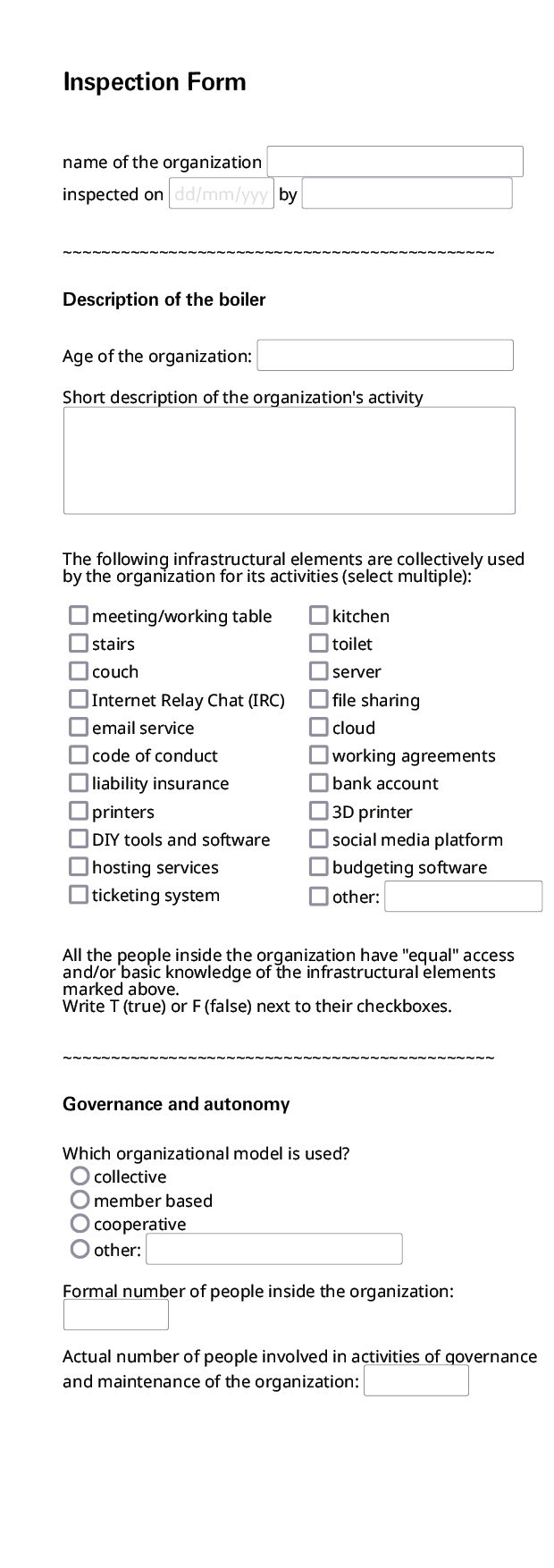
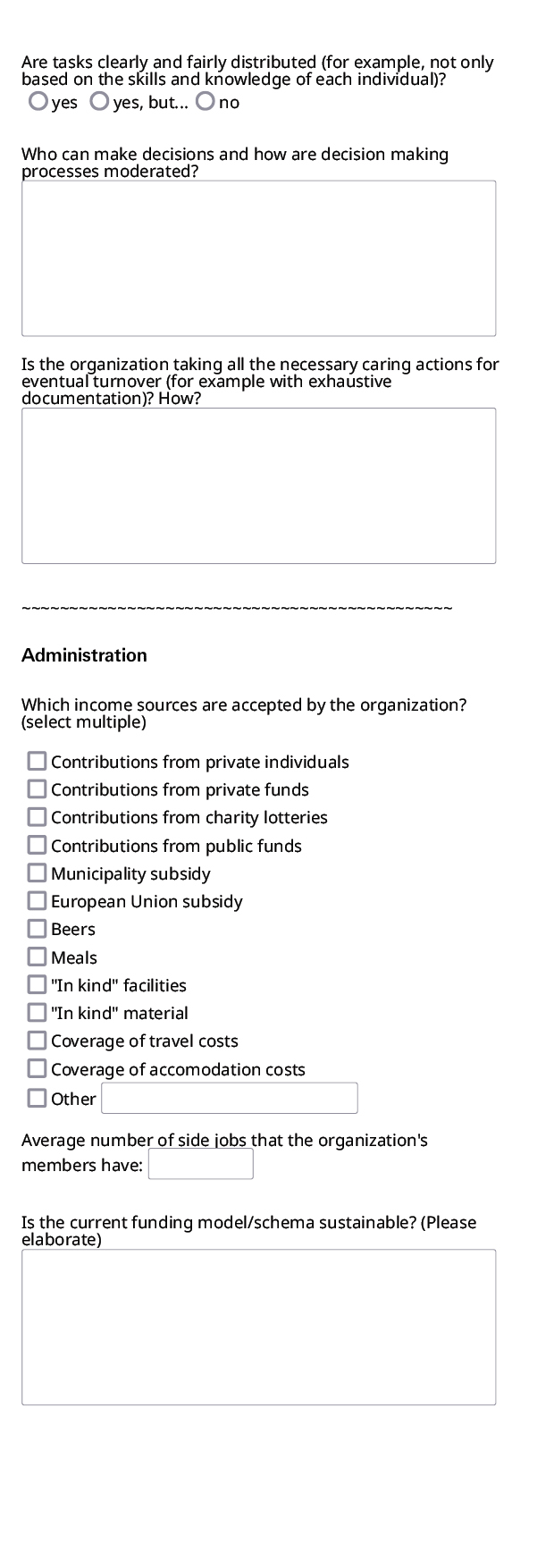
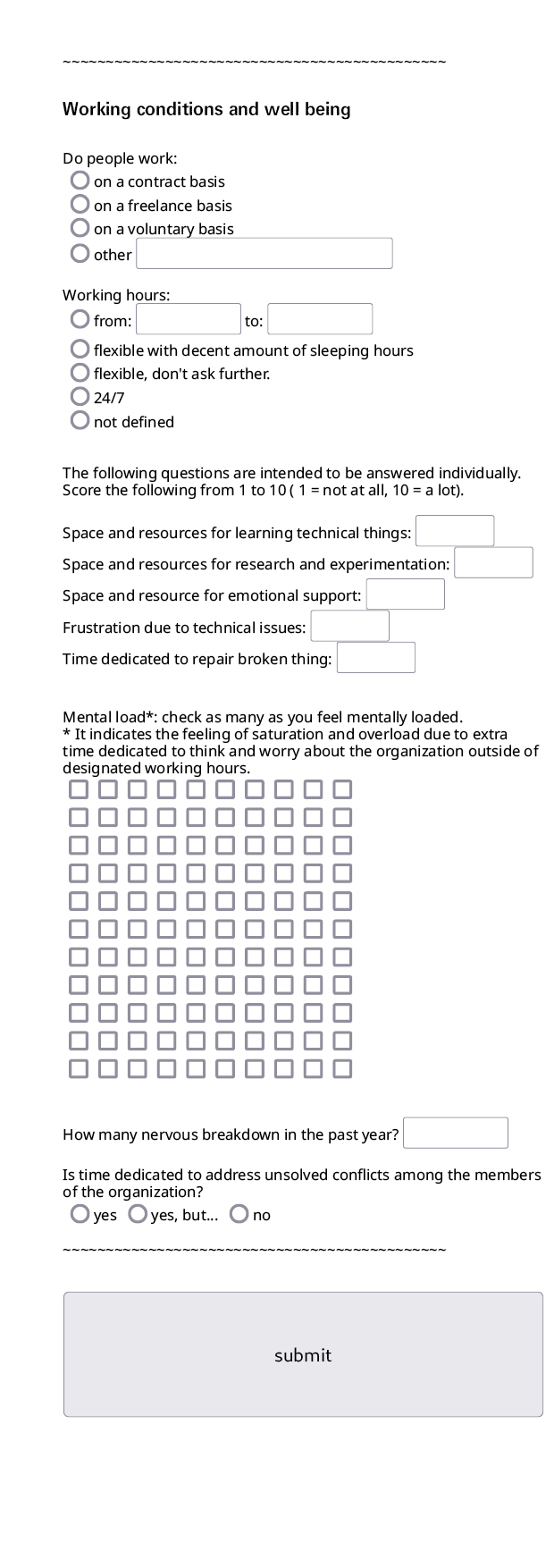
Colophon
Contributors: Sara Fumaça, Michael Fowler, Juliette Lizotte, the DIWO Working Group, Adèle & Leo, Erica Gargaglione, slvi.e, Anja Groten, Florence Walker, Daniel Murray, Clara Pasteau Editing: slvi.e, Loes Bogers Design: Juliette Lizotte, Anja Groten Typefaces: BBBSprat by Eugénie Bidaut, Julie Patard et al., DINdong by Clara Sambot, Amiamie – Mirat Masson et al.,BBB Baskervvol by Bye Bye Binary et al., found on Bye Bye Binary’s Typotheque: https://typotheque.genderfluid.space Since 2018, the Bye Bye Binary collective has been actively working on the design of post-binary fonts to enable the language to move beyond the debates around inclusive writing. Riso printing: by Kimberley Cosmilla in the studio of Zuzana Kostelanská & Oriol Cabarrocas. Tool: Octomode https://cc.vvvvvvaria.org/wiki/Octomode Published by: Hackers & Designers NDSM-plein 1033 WC Amsterdam www.hackersanddesigners.nl With the kind support of Stimuleringfonds Creative Industries
License COLLECTIVE CONDITIONS FOR RE-USE(CC4r) Hackers & Designers, 2025. Copyleft with a difference: This is a collective work, you are invited to copy, distribute, and modify it under the terms of the CC4r.
REMINDER TO CURRENT AND FUTURE AUTHORS: The authored work released under the CC4r was never yours to begin with. The CC4 reconsiders authorship to be part of a collective cultural effort and rejects authorship as ownership derived from individual genius. This means recognizing that it is situated in social and historical conditions and that there may be reasons to refrain from release and re-use. Copyleft Attitude with a difference, 24 November 2022.
The CC4r was developed for the Constant work session Unbound Libraries (Spring 2020) and followed by discussions during and contributions to the study day Authors of the Future (Fall 2019). It is based on the Free Art License and inspired by other licensing projects such as The (Cooperative) Non-Violent Public License and the Decolonial Media license.